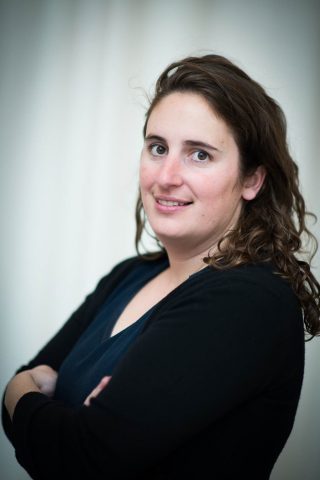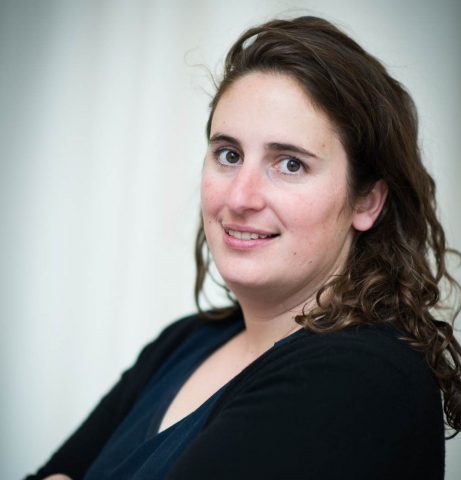
What’s your background?
I first graduated as a bio-engineer at the University of Leuven and then moved to London for a master’s degree in clinical neuroscience. This is where I enrolled in research into neurodegenerative disorders: diseases in which brain cells die off, such as Parkinson’s disease, Alzheimer’s disease, ALS…
What has driven you to do research on Parkinson’s disease?
The fact that I ended up working on Parkinson’s was rather a coincidence. For my Master thesis I went in a research lab that did research into both Parkinson’s and Alzheimer’s disease. There was someone missing in the Parkinson’s team, so that’s how I got involved at first. Once I started, I was immediately bitten and worked on it in my PhD in the years that followed.
What research are you working on currently for Parkinson’s disease?
The research I did is very molecular: it’s about genes and proteins, so it was done exclusively in the lab. In other words, I did not study with patients. Yet this lab research is extremely important. If we want to develop effective treatment for Parkinson’s disease, which can stop, reverse or perhaps even prevent it, then we need to understand exactly what goes wrong in patients’ brain cells. Although we know in general which processes go wrong, we are still in the dark about many aspects.
Molecular research, not only into PINK1, but also the other genes associated with Parkinson’s disease, can provide insight into this. Even though the hereditary forms of Parkinson’s are rather rare, the genes can put us on the track of the common disrupted biological processes, where things also go wrong with the non-hereditary forms of Parkinson’s disease for other reasons.
Where are you doing your this research?
For my master’s I did some research in London and then started my doctoral research in Leuven in the lab of Professor Bart De Strooper.
Why did you choose to communicate about Parkinson’s disease?
Unfortunately, there is no real treatment for Parkinson’s disease for the time being. As long as there is no real breakthrough, it may seem to patients that nothing is happening, but nothing is further from the truth. I think it’s important that patients, too, know that there’s a lot of research – and how it works. After all, it is for them that we do it.
What have you just discovered?
One of the genes that cause rare hereditary forms of Parkinson’s disease is PINK1. Errors in this gene lead to a form of Parkinson’s disease that breaks through at an early age. To understand why genetic errors in the PINK1 gene cause Parkinson’s disease, we need to look for the role of the protein encoded by this gene. What does it do under normal circumstances and what goes wrong when the gene is damaged?
The PINK1 protein is a so-called ‘kinase’, a type of protein that activates (or inactivates) other proteins through a specific chemical reaction (applying a phosphate group to the target). In my research I worked with purified PINK1 protein to see when it is active and which other proteins it can activate.
What do you think are the most promising research breakthroughs in the Parkinsonian domain?
Research consists of small steps forward in which teams worldwide deliver brick by brick. It is therefore very difficult to achieve one specific breakthrough. I am very curious about the results of the first clinical studies based on the genetic insights about Parkinson’s disease. They build on the results of the past two decades, but could possibly propose a whole new approach to treatment.
In the basic research, it is encouraging to see that organisations such as the Chan-Zuckerberg Initiative of Facebook boss Mark Zuckerberg and his partner Priscilla Chan are also throwing their full weight (and dollars) into the development of better disease models for Parkinson’s disease.
When do you think there will be a solution for Parkinson’s disease?
That’s very difficult to predict. Compare research with climbing a mountain without a map. When you’re climbing, you can’t always see the summit, and even when you reach it, you sometimes have to conclude that the next summit in the mountain range is a lot higher, and you still have to move on to a new goal.
Sometimes progress seems slow – far too slow for patients unfortunately – but every year we learn more about Parkinson’s disease. The problem is difficult and complex, but there is no reason to think that it would be impossible to find new treatments. With sufficient resources and willpower, there is a solution to almost every problem. We landed on the moon decades ago, and I firmly believe that sooner or later we will also have a better understanding of the biological processes in our brains and will be able to cope with diseases such as Parkinson’s disease.
You support the Demoucelle Parkinson Charity; what motivated you?
I attended a motivational seminar by Patrick and Anne-Marie. Their positive attitude was very inspiring. I wanted to communicate more about research, so I hoped that I could help the Demoucelle Parkinson Charity a little.
Nice anecdote: I came into contact with Patrick and Anne-Marie at a time when my research was not going well. The first time I met them we talked about disease processes and they fired all their questions at me. It was a huge boost for me. My experiments in the lab just didn’t work out and I sometimes wondered if all that work was still worth it. By talking to them about what we do and don’t know about the molecular disease processes I realized that even without breakthroughs in the lab I could still make a difference. (Luckily the results followed later.)
What is your favorite quote?
I can’t choose between these two:
“No one cares how much you know until they know how much you care.” Theodore Roosevelt; because scientific communication and passing the knowledge to those who need it, in this case Parkinson’s disease patients, is so important.
“Never believe that a few caring people can’t change the world. For, indeed, that’s all who ever have.” Margaret Mead; because scientific research involves a lot of trial and error, and it is sometimes difficult to keep up the courage and not to lose sight of ‘the big picture’.
